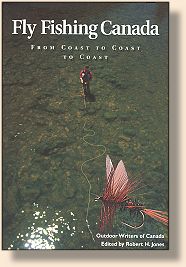Fly-Ins, Part 5
By Dr.Martin Lamont
From Fly Fishing Canada From Coast to Coast, Published
by Johnson Gorman Publishers. We appreciate use permission.
The Rocky Mountains and Alpine Adventure
Situated amid the western slopes of the Rocky
Mountains in Golden, British Columbia, a good
departure point to remote, spectacular Fortress
Lake. The only access to the lodge at Fortress
is by a long hike in from Alberta or a short hop
in a 185 Cessna floatplane from Golden. The
latter is the choice of most anglers.
Located in British Columbia, just west of the Alberta
border, Fortress Lake is an narrow body of water about
7 miles (11 km) long. It supports large native bull
trout to 15 lb (7 kg), lake trout to 20 lb (9 kg) and
brook trout, which were mistakenly planted between 1920
and 1930 by Alberta Fish and Wildlife personnel who
thought the lake was in Alberta. The brookies are
now naturalized and grow to 5 lb (2 kg).
One fall, when a friend visited from Italy, we decided
to hike in on a route starting at the southwest corner
of Jasper National Park. We were well prepared with
hiking gear and camping equipment for our 16-mile (26 km)
jaunt, including multiple freshwater fishing licenses
for Alberta, British Columbia, and Jasper National Park.
We drove Highway 93, the Icefield Parkway, and left our
vehicle at the Honeymoon Lake campground.
The hiking trail starts close to where the Sunwapta
River meets the big Athabasca River. The Sunwapta is
part of the upper Athabasca drainage, and here we fished
the confluence for bull trout, brook trout, whitefish,
and occasional rainbows to 3 lb (1.5 kg). Luckily, it
was late summer, so the river was finally running clear
of silt from high altitude snowmelt. Our trek was
delayed by many fine fish.
Our plans included taking pack rods. My favorite for
small lakes and rivers is an old fiberglass fly rod - a
7', 2.5-weight, sturdy enough to handle the abuse
encountered in camping situations. It works great with
a shortened 5-weight shooting head, performs well for
close-river casting, and attached to a light running
line, it can be cast a mile when necessary on the lakes.
A 7-weight, 9' rod which breaks down to 18" (46 cm) was
in reserve for the big lake.
The trail followed southward along the Chaba River and
required a challenging fording of the river to eventually
reach the remote back-country campsite at the lake's east
end. On the trail we heard and saw several helicopters
in the distance. They were flying out of Canmore, Alberta,
with heli-hikers and anglers. Westward down the long lake,
Serenity Glacier and the Hooker Icefield dominated the
scene, and to the north, Fortress Mountain rose over
3,000' (9 m).
Upon reaching the lake we pressed on to comfortable
Fortress Lake Lodge, where we were make welcome in
tent-camp accommodations and provided with good food
and the latest fishing reports. Our hosts said fish
were present in several feeder rivers and creeks and
at the outlet. We were told that fishing is best right
after ice-out in June and that the overall drifts of
schools of brook trout was from the east end in the
spring and to the west by season's end.
The following day we were provided with a 14' aluminum
boat and outboard motor to search out the schools. We
boated all over the lake, checking for shoreline cover
such as submerged logs, trees that had blown down along
the shoreline, points, bars and drop-offs, plus any
inlets that looked like holding water. Using fast-sinking
lines we tried No. 6 - 2 Leeches and Woolly Buggers in
black, olive and yellow, and a few sculpin and fry patterns.
Once fish were located there was a tendency for sudden
action at each location. Brook trout do not show at the
surface, so we kept scanning the lakes for physical
characteristics that might prove attractive to them.
Growing whitecaps blew us off the lake in the late
afternoon, by which time we had a few good fish to
our credit.
 Around midmorning the next day, a floatplane from Golden
arrived with a new party of anglers. The return flight
was not booked - a perfect opportunity for us
"hide-in-fly-out" lazybones. The floatplane was buffeted
violently on the trip, but the bumpy air time was well
under an hour - hardly long enough to reflect on our
wonderful alpine fishing adventure.
Around midmorning the next day, a floatplane from Golden
arrived with a new party of anglers. The return flight
was not booked - a perfect opportunity for us
"hide-in-fly-out" lazybones. The floatplane was buffeted
violently on the trip, but the bumpy air time was well
under an hour - hardly long enough to reflect on our
wonderful alpine fishing adventure.
Continued Next Time
Credits: Excerpt from Fly Fishing
Canada written by Outdoor Writers of Canada,
edited by Robert H. Jones, Published by Johnson
Gorman Publishers. Used with permission.
Our Man In Canada Archives
|

 Around midmorning the next day, a floatplane from Golden
arrived with a new party of anglers. The return flight
was not booked - a perfect opportunity for us
"hide-in-fly-out" lazybones. The floatplane was buffeted
violently on the trip, but the bumpy air time was well
under an hour - hardly long enough to reflect on our
wonderful alpine fishing adventure.
Around midmorning the next day, a floatplane from Golden
arrived with a new party of anglers. The return flight
was not booked - a perfect opportunity for us
"hide-in-fly-out" lazybones. The floatplane was buffeted
violently on the trip, but the bumpy air time was well
under an hour - hardly long enough to reflect on our
wonderful alpine fishing adventure.